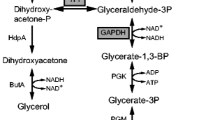Abstract
Sorghum vulgare phosphoenolpyruvate carboxylase (PEPC) and Lactococcus lactis pyruvate carboxylase (PYC) were overexpressed in Escherichia coli concurrently to improve the production of succinate, a valuable industrial specialty chemical. This coexpression system was also applied to E. coli mutant strains strategically designed by inactivating the competing pathways of succinate formation. The highest level of succinate production was observed in E. coli strains coexpressing both PEPC and PYC when compared with E. coli strains individually overexpressing either PEPC or PYC. Lactate production was also significantly reduced with PEPC and PYC coexpression. Lactate and acetate pathways were inactivated to eliminate the competing pathways of succinate formation. Results showed that inactivation of both the lactate and acetate pathways with the coexpression of PEPC and PYC was most effective in improving succinate production. Inactivating the lactate or acetate pathway alone only caused a majority of the carbon flux to shift to other metabolites rather than succinate. Coexpression of PEPC and PYC was also applied to an E. coli mutant strain deficient in lactate dehydrogenase and pyruvate:formate lyase that accumulated a substantial amount of the intermediate metabolite pyruvate during growth. Results showed that PEPC and PYC coexpression was effective in depleting pyruvate accumulation and increasing the production of metabolites.




Similar content being viewed by others
References
Berrios-Rivera SJ (2002) Metabolic engineering of cofactors (NADH/NAD+) in Escherichia coli. PhD thesis, Rice University, Houston
Bunch PK, Mat-Jan F, Lee N, Clark DP (1997) The ldhA gene encoding the fermentative lactate dehydrogenase of Escherichia coli. Microbiology 143:187–195
Blackwood AC, Neish AC, Ledingham GA (1956) Dissimilation of glucose at controlled pH values by pigmented and non-pigmented strains of Escherichia coli. J Bacteriol 72:497–499
Chatterjee R, Millard CS, Champion K, Clark DP, Donnelly MI (2001) Mutation of the ptsG gene results in increased production of succinate in fermentation of glucose by Escherichia coli. Appl Environ Microbiol 67:148–154
Donnelly MI, Millard CS, Clark DP, Chen MJ, Rathke JW (1998) A novel fermentation pathway in an Escherichia coli mutant producing succinic acid, acetic acid, and ethanol. Appl Biochem Biotechnol 70-72:187–198
Gokarn RR, Eiteman MA, Altman E (1998) Expression of pyruvate carboxylase enhances succinate production in Escherichia coli without affecting glucose uptake. Biotechnol Lett 20:795–798
Gokarn RR, Eiteman MA, Altman E (2000) Metabolic analysis of Escherichia coli in the presence and absence of the carboxylating enzymes phosphoenolpyruvate carboxylase and pyruvate carboxylase. Appl Environ Microbiol 66:1844–1850
Gokarn RR, Evans JD, Walker JR, Martin SA, Eiteman MA, Altman E (2001) The physiological effects and metabolic alterations caused by the expression of Rhizobium etli pyruvate carboxylase in Escherichia coli. Appl Microbiol Biotechnol 56:188–195
Lin H, Vadali RV, Bennett GN, San K-Y (2004) Increasing the acetyl-CoA pool in the presence of overexpressed phosphoenolpyruvate carboxylase or pyruvate carboxylase enhances succinate production in Escherichia coli. Biotechnol Prog (in press)
Millard CS, Chao Y, Liao JC, Donnelly MI (1996) Enhanced production of succinic acid by overexpression of phosphoenolpyruvate carboxylase in Escherichia coli. Appl Environ Microbiol 62:1808–1810
Payne J, Morris JG (1969) Pyruvate carboxylase in Rhodopseudomonas spheroides. J Gen Microbiol 59:97–101
Phillips GJ, Park S-K, Huber D (2000) High copy number plasmids compatible with commonly used cloning vectors. Bio Techniques 28:400–408
Sambrook J, Fritsch EF, Maniatis T (1989) Molecular cloning: A laboratory manual, 2nd edn. Cold Spring Harbor Laboratory, Cold Spring Harbor, N.Y.
Schilling LB (1995) Chemicals from alternative feedstocks in the United States. FEMS Microbiol Rev 16:101–110
Yang Y-T (1999) Metabolic engineering and flux analysis of Escherichia coli. PhD thesis, Rice University, Houston
Yang Y-T, San K-Y, Bennett GN (1999) Redistribution of metabolic fluxes in Escherichia coli with fermentative lactate dehydrogenase overexpression and deletion. Metabolic Eng 1:141–152
Zeikus JG, Jain MK, Elankovan P (1999) Biotechnology of succinic acid production and markets for derived industrial products. Appl Microbiol Biotechnol 51:545–552
Acknowledgements
This work was supported by grants from the National Science Foundation (BES-0222691, BES-0000303). H.L. was supported by a training grant from the National Science Foundation (DGE0114264)
Author information
Authors and Affiliations
Corresponding author
Rights and permissions
About this article
Cite this article
Lin, H., San, KY. & Bennett, G.N. Effect of Sorghum vulgare phosphoenolpyruvate carboxylase and Lactococcus lactis pyruvate carboxylase coexpression on succinate production in mutant strains of Escherichia coli. Appl Microbiol Biotechnol 67, 515–523 (2005). https://doi.org/10.1007/s00253-004-1789-x
Received:
Revised:
Accepted:
Published:
Issue Date:
DOI: https://doi.org/10.1007/s00253-004-1789-x




